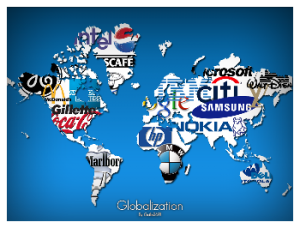Creative Destruction required for world’s progress
 Creative destruction is a process through which something new brings about the termination of something existed before it. Creative destruction is required for progress of society. Until we discard the old, new cannot be brought in. It is a term in economics which has since the 1950s become most readily identified with the Austrian American economist Joseph Schumpeter. The term is used in almost all walks of life including economics, corporate governance, product development, technology, distribution, supply chain management, human resource development and marketing. In product development, for example, creative destruction is roughly synonymous with unruly technology. Often to describe creative destruction the common example is of the smart phone, which almost killed the market for not only regular cell phones but also PDAs, MP3 players, point-and-shoot cameras, wrist watches, calculators and voice recorders- among other things. So, even if smart phone killed market of so many gadgets, it brought with it creativity hence the term “creative” is used.
Creative destruction is a process through which something new brings about the termination of something existed before it. Creative destruction is required for progress of society. Until we discard the old, new cannot be brought in. It is a term in economics which has since the 1950s become most readily identified with the Austrian American economist Joseph Schumpeter. The term is used in almost all walks of life including economics, corporate governance, product development, technology, distribution, supply chain management, human resource development and marketing. In product development, for example, creative destruction is roughly synonymous with unruly technology. Often to describe creative destruction the common example is of the smart phone, which almost killed the market for not only regular cell phones but also PDAs, MP3 players, point-and-shoot cameras, wrist watches, calculators and voice recorders- among other things. So, even if smart phone killed market of so many gadgets, it brought with it creativity hence the term “creative” is used.
 Creative destruction is inevitable. We are living in a world of constant climatic change, constant trend change, constant cultural change which is so threatening at times. The social fabric itself is changing. All that we can to is accept it, if we cannot control it. Aren’t we all abandoning our old way of living and thinking in order to fit and live in today’s self-absorbed world thinking more effectively and profitably?
Creative destruction is inevitable. We are living in a world of constant climatic change, constant trend change, constant cultural change which is so threatening at times. The social fabric itself is changing. All that we can to is accept it, if we cannot control it. Aren’t we all abandoning our old way of living and thinking in order to fit and live in today’s self-absorbed world thinking more effectively and profitably?
 In advertising, every new creative ad for an existing product/service is an excellent example of creative destruction. It targets at newer markets, while risking isolation of an existing one. Medical science is another great example of creative destruction. Creative destruction is constantly changing the modern medicines. Besides new drug delivery system, newer molecules, new operative methods it is changing the average human’s everyday life. The medical discoveries are designed for groups. The interactions of drugs, patients, and diseases are unpredictable; clinical trials are population based and do not account for personal idiosyncrasies and much less medical histories. What if your cell phone helps detect cancer? Did this take you back? It seems beyond reading email and surfing the Web, it will soon be checking our vital signs. It sounds terrifying yet, handy. It will constantly monitor our heart rhythm, blood glucose levels, and brain waves even while we sleep. The miniature ultrasound imaging devices fixed in smart phones will soon replace the icon of medicine – the stethoscope. So friends we never know new innovations might bring such drastic changes in our lives, which are indistinct and unimaginable at the moment.
In advertising, every new creative ad for an existing product/service is an excellent example of creative destruction. It targets at newer markets, while risking isolation of an existing one. Medical science is another great example of creative destruction. Creative destruction is constantly changing the modern medicines. Besides new drug delivery system, newer molecules, new operative methods it is changing the average human’s everyday life. The medical discoveries are designed for groups. The interactions of drugs, patients, and diseases are unpredictable; clinical trials are population based and do not account for personal idiosyncrasies and much less medical histories. What if your cell phone helps detect cancer? Did this take you back? It seems beyond reading email and surfing the Web, it will soon be checking our vital signs. It sounds terrifying yet, handy. It will constantly monitor our heart rhythm, blood glucose levels, and brain waves even while we sleep. The miniature ultrasound imaging devices fixed in smart phones will soon replace the icon of medicine – the stethoscope. So friends we never know new innovations might bring such drastic changes in our lives, which are indistinct and unimaginable at the moment.
 Joseph Schumpeter, an Austrian-American economist, developed the concept of creative destruction from the works of Karl Marx, in reference to capitalist development and the business cycle. According to Schumpeter’s theory, creative destruction will lead to the eventual failure of capitalism as an economic system. In current business use, the term is more likely to refer to unpleasant choices that are considered necessary for sustainability. It will fail capitalism because the creativity and innovation finally will reach the lowest stratum of business – the micro, cottage and small businesses.
Joseph Schumpeter, an Austrian-American economist, developed the concept of creative destruction from the works of Karl Marx, in reference to capitalist development and the business cycle. According to Schumpeter’s theory, creative destruction will lead to the eventual failure of capitalism as an economic system. In current business use, the term is more likely to refer to unpleasant choices that are considered necessary for sustainability. It will fail capitalism because the creativity and innovation finally will reach the lowest stratum of business – the micro, cottage and small businesses.
As the economist Schumpeter saw it, creative destruction is a positive force, which drives away weaker companies to disappear and be replaced by more innovative and competitive ones. The Austrian American economist himself wrote in his 1942 book “Capitalism, Socialism and Democracy”, it’s a process that “incessantly revolutionizes the economic structure from within, incessantly destroying the old one, relentlessly creating a new one. This was the time when the world was facing the World War II. It involved the vast majority of the world’s nations. It included all of the great powers; which eventually formed two opposing military alliances: the Allies and the Axis. It was the most widespread war in history, and directly involved more than 100 million people, from more than 30 different countries. Schumpeter’s creative destruction theory was shaped in the background of a changing world – cruelty, competition and destruction.
In today’s world competition is constantly driving prices and lowering margins resulting into commoditization of products. How much ever marketers dislike commoditization, it is helping the economically weaker sections of society. Similarly, the digital revolution hit the computer makers first; driving companies like IBM, Infosys, Microsoft and HP into a restructuring which cost these companies scrapping a millions of jobs, but it connected the world. The power of ever-cheaper computing then moved on to attack other companies too, because it enabled smaller companies to arrange the computational resources that only big ones previously had. This truth abruptly removed major barriers to entry. Companies all over the world could lower their operating costs, increase their IT capabilities, and improve their own business models by creating better products and services at lower prices. Though new technologies play havoc sometimes, they are the change drivers. Look it positively – it gave the same computational powers to the smaller companies that only big corporations used to have! This is the beauty of creative destruction. The revolution in social media gave the world new platforms; today the world has really become a global village. The social media has made it possible for people anywhere in the world to instantly connect, share information, and create communities. The conventional media was crashed by the new-found social media; hats off to creative destruction in media business.
 The revolution in IT and social media brought in the wake of globalization. Making competition inevitable globally; competitors can now come from any part in the world, no matter what the product is, market or industry is.
The revolution in IT and social media brought in the wake of globalization. Making competition inevitable globally; competitors can now come from any part in the world, no matter what the product is, market or industry is.
Often one thought annoys everybody’s mind that is we are now living in an unsettled world of economic upheavals, territorial and religious disputes, shifting demographics, and a very rapid rate of change. And, all of this paradoxically contributes to running faster to stay in place. Globalization has affected every sphere of society and human living. To keep pace with other countries of the world, all aspects of the technology and its usage need to be brought in education. Knowing the application of technology and technological systems and concepts is not likely to solve the whole problem unless we will be able to sensitize the students to real time issues. Updating the teaching-learning process is a compulsive requirement.
 Globalization is having a major impact on education in several ways – in financial terms, in historical terms and in sociological terms. Most governments are under pressure to reduce their spending on many other heads to expand their educational systems. The quality of national education systems is increasingly being compared internationally. This has placed increased emphasis on mathematics, science and the humanities curriculum, standards, and assessments. Globalization has made nations and people increasingly interdependent. This interdependence materializes in increased international flows of goods and services, of financial funds, labour and ideas. The aspect of increased international flows of ideas is the most relevant one for growth of developing nations. Changing educational policies is of paramount importance. Let me put it this way – education requires creative destruction constantly. Many countries increasingly aim at preparing pupils for a globalized world. Education needs to style the young minds in becoming entrepreneurs. In countries like German, France, England, America, China swift and spiky educational policies are put in place to shape and mould the innovative potential of teens in the schools. These progressive nations are debating on how to make education proactive for facing the ever changing world.
Globalization is having a major impact on education in several ways – in financial terms, in historical terms and in sociological terms. Most governments are under pressure to reduce their spending on many other heads to expand their educational systems. The quality of national education systems is increasingly being compared internationally. This has placed increased emphasis on mathematics, science and the humanities curriculum, standards, and assessments. Globalization has made nations and people increasingly interdependent. This interdependence materializes in increased international flows of goods and services, of financial funds, labour and ideas. The aspect of increased international flows of ideas is the most relevant one for growth of developing nations. Changing educational policies is of paramount importance. Let me put it this way – education requires creative destruction constantly. Many countries increasingly aim at preparing pupils for a globalized world. Education needs to style the young minds in becoming entrepreneurs. In countries like German, France, England, America, China swift and spiky educational policies are put in place to shape and mould the innovative potential of teens in the schools. These progressive nations are debating on how to make education proactive for facing the ever changing world.
Let us seriously look at our education standards; only theoretical knowledge, mugging up, and higher grades is not leading us anywhere. Emphasizing on humane aspects as the core of an education system for skill development and its application is the need of the hour. The future of the country largely depends on the qualitative learning system.This, keeping in mind that half of India’s population will be below 30 years of age by 2020. Knowledge should be application oriented with changing times. Are the policy makers listening?













































